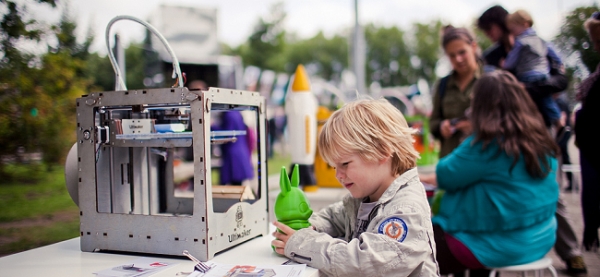"3D printing has helped empower the creativity of students to create complex and unique art pieces."
Design & Technology
Complex designs and products can be printed and manufactured quickly and efficiently. The process of 3D printing enables a more seamless process, allowing the user to modify changes to the design, tailor sizing, add additional features and allow the user the option to utilise a variety of materials, ranging from traditional plastics in solid or transparent colours to wood, chalk and rubber. The entirety of this process creates a great foundation for Higher Education.
3D Printing Robots
Robotics and 3D printing are closely becoming aligned, with leading robotic androids now featuring 3D printable parts. The importance of robotics within education remains in its infancy, although sectors such as warehousing, manufacturing, engineering, finance and technology have been transformed.
3D printable robots capture the imagination of adults, let alone students, and more importantly educates learners on a variety of key skills such as engineering, mechanics, electronics and programming.
Art
3D printing has challenged the traditional concepts and processes in art, and has taken the modern art movement to another level creating a new generation of artists and enthusiasts. It has helped empower the creativity of students to create complex and unique pieces, from jewellery, abstract shapes and concepts to replicating traditional art forms such as statues, vases and interior design pieces.
Science
"Designs can be versatile, and 3D printing can capture and aid the imagination and translation of all aspects within education."
The ability to innovate science can be seen with the rise of industry bio and medical 3D printers. The introduction of these at an early stage will demonstrate the first foundation of how this technology is changing the landscape of medicine, healthcare and science. 3D printing can be used in a variety of formats such as printable dissection kits used to illustrate key organs and discuss how they work and fit together. Moveable joints, working mechanical hands and a pivoting solar system can also illustrate the subject area in a visual and interactive format, making the textbooks come to life, creating and necessitating group projects and activities.
History, Geography, Maths. The possibilities are endless
Learning can come to life by turning back time and creating dinosaurs, fossils and historical features such as pyramids, Roman helmets and castles. Designs can be versatile, able to be printed as a whole or in stages to demonstrate key syllabus objectives. 3D printing can capture and aid the imagination and translation of all aspects within education; it can transform the way we learn and voice our creative thoughts.
Education Packs and Structured Syllabus Aids
With all new technologies, the concept can seem, at times, confusing and complicated. However, we are now entering the third generation of desktop 3D printing, and the process is as simple as plug and print. The design process could be considered daunting, but with software such as Google Sketchup and TinkerCad, 3D CAD design has also become a simple process for all ages and skill-sets.
The cost of 3D printing and printers has decreased significantly and will continue on this trend, making it an accessible and necessary tool within educational institutions. With a variety of education-friendly 3D printers available, the justification of this innovating technology cannot be taken lightly, as its impact on the next generation has only just begun.
Do you use 3D printing in your school? Let us know in the comments.


















